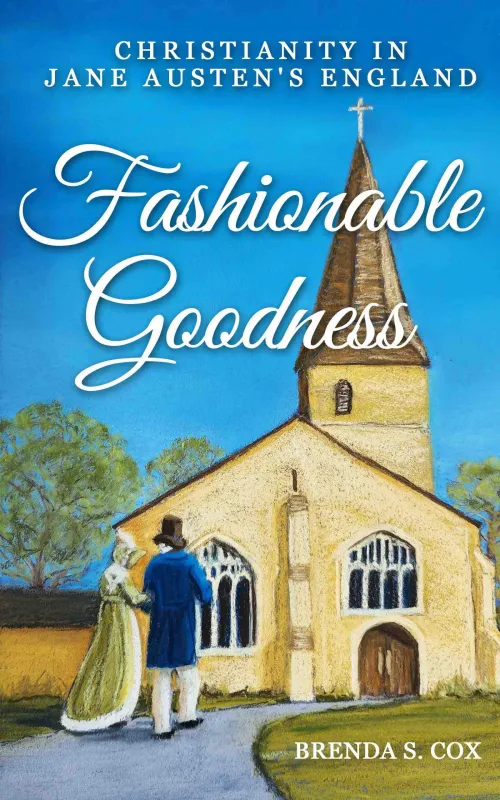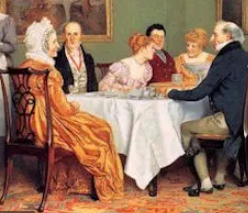We have come to associate the Regency period with fine white, high-waisted muslin dresses that were beautifully detailed and embroidered. Until quite recently in human history, a lady did not roam far from her sewing basket. She would mend, sew, and embroider whenever she had spare time. (Even the finest lady in the land could be found plying her needles.) During the day she would sit near a well lit window or even outdoors, and during the long evening hours she would sit by the fireside in a room with other family members, sharing the light from expensive candles (sometimes a single one). For entertainment, one of the men would read aloud from a book, or other family members would play musical instruments. Jane Austen was well known for her sewing skills and examples of her needlework are shown in the Jane Austen Museum in Chawton.
White work is a broad term, one that may be said to encompass any white-on-white needlework, that is, needlework that uses a white yarn or thread on a white ground to create a pattern. Various techniques are employed to make these patterns stand out in high relief against their monochrome background, with the result that many white work pieces have an intensely sculptural quality
All over the country, women carried their needlework with them on visits, and traded patterns among friends.
These techniques include embroidery, drawn work, pulled-fabric work, stump work, stuffed work, cording, quilting, candlewicking, and, later, weaving, both by draw loom and machine. – From Lap to Loom: The transition of Marseilles white work from hand to machine
Whitework embroidery was frequently used on muslin dresses, fine lawn caps, handerkerchiefs, tablecloths, and bed linens. Patterns were featured in Ladies Periodicals, showing many different motifs, some fancier than others.
The finest whitework was done on cambric and fine muslin, or netting. This was called French embroidery, or French Hand Sewing. The most delicate threads and techniques were utilized to make gorgeous, lacy handkerchiefs, veils, bonnets, cuffs, collars and baby clothes, as well as gifts to very special friends…
Christening gowns and robes of the time were very heavily embroidered and were most treasured by their owners. Lots of different patterns and stitches were used, with lots of feather stitching all over, leading to flowers made of satin stitch, eyelets, and buttonhole stitches so tiny as to be difficult to see, and almost all with matching bonnets and slips or petticoats. French knots decorated edges.
Wedding gowns, too, were embroidered with these techniques, and some of the grooms’ clothes, too, were embroidered to match! – Whitework embroidery
More on the topic:
















These examples are so beautiful! I wish I had the patience to do similar work.
The labour of love that went into clothes in Regency times really puts us to shame with our disposable fashion mentality.
Thanks for the post Vic!
I’m in awe of their attention to detail and the time spent to create such lovely needlework!
[…] more here: 18th & 19th Century Whitework Embroidery « Jane Austen's World 20th Century Steel Band: Warm Heart, Cold Steel (Mr Bongo …Unbound: Webcomics in print […]
Practising embroidery nowadays, I can admire how difficult, and fine , this needle work is..So beautyful!
I found this just fascinating. I had never given must thought as to how all that embroidery got on the clothing. I do have a question though — How did they transfer the embroidery patterns to the fabric?
Thanks again,
Melanie
Beautiful examples of needlework! I hope it never becomes a lost art. GREAT POST to share!
Thanks for the post on whitework embroidery! The pictures are gorgeous!
Thanks for the compliments, all. Hi Melanie. Transferring a pattern is simple. You hold the cloth up to a window or light box so that you can see the pattern through the cloth and then lightly trace it. (This works best if the cloth is affixed with tape to the surface.) You can also punch needle holes along the lines and into the paper and sprinkle a light powder over the needle holes onto a dark ground or a darker powdered substance over light cloth. I would choose the first method, and have found my large sliding doors to be invaluable in the process. First tape the pattern to the window, then the area of cloth you’d like to embroider over the pattern, trace with soft pencil (perhaps a blue one, so that the lines are faint) Repeat the process until the entire hem, or area you want to embroider has been traced. Sewers – any other suggestions?
I like the picture of “domestic happiness.” Man reading, women sewing…
I’m inspired to finally finish the pillow cases I began embroidering last year. I love the look of whitework – so subtle and classy! That last picture of the dress hem is unbelievably gorgeous.
Beautiful examples, Vic. Can you imagine how difficult it was to keep these articles stain-free, clean and white?
~Jo~
I have never done white work, but I love to do black work–beside black thread, also using only red or even blue thread on white background.
Thank you for your post, interesting info.
Vic, I should have been more clear in my comment. How would 18th Cen. ladies transfer the patterns. I can see that using a window as a “light box” would probably be used for smaller pieces. But they wouldn’t tape or blue pencils.
And I should have said that I love your blog! I’ve been lurking here for some years now. It’s one of the places I come to when I’ve feeling down. It always takes me out of myself.
Thanks!
Melanie, Thank you for your remarks. I did not want to presume to know how the Georgians transfered patterns to clothing, so I must admit I used my knowledge from art history about how painters transfered their patterns, and how I transfer my own sewing patterns..
Painters in the Renaissance transfered their designs to walls for fresco paintings from designs on paper by puncturing holes in the paper and transferring the pattern by rubbing charcoal over the holes.
I don’t know how long tailor’s chalk has been in existence, but by the turn of the 20th century, patterns were transferred by puncturing holes in the transfer paper and rubbing tailor’s chalk over the puncture marks. This chalk comes in three colors today: white, blue and pink. The modern seamstress can also purchase a substance called dressmaker’s carbon. The Victoria and Albert Museum says this about the technique:
Dear Vic,
It’s almost as if you read my mind. For the last week I kept hesitating about emailing you for help and then deciding that it would be a cheek…
( I agree with Melanie – this is a wonderful blog.)
I have reached the point in my sequel to ‘I Was Jane Austen’s Best Friend’ where I needed to describe a delectable wedding dress and I kept looking at Mrs Elton’s phrase in ‘Emma’ saying disdainfully: ‘very little white satin, very few lace veils..’.
I want my heroine to have white satin and lace, paid for by her wealthy Uncle Leigh-Perrot, but did they wear the veil over their heads, or over their gowns? This is what is puzzling me.
And what will Jane wear? In reall life, she was bridesmaid to Jenny (Jane Cooper).
Do you know about lacemakers’ lamps? They were ordinary oil lamps with a globe filled with water for magnification purposes. I read about that when I was doing a book about the Irish Famine (thirty years after Jane’s death.
Many thanks, again, Vic,
Cora.
Cora, Again, these compliments are a boon to my soul. Thank you. Thank you for the hint about Lacemaker Lamps. Have you seen this link to lace fairy.com? What an excellent description of these lamps. http://lace.lacefairy.com/Lace/Gallery/LaceLamps.html
Bridal Veils:
Certain lengths of bridal veils got their names from how or where they were worn. At one time, Cathedral Veils were only worn in wedding that took place in cathedrals.
Interestingly, veils were not always worn by brides in Regency era weddings. Look at this image of Princess Charlotte, who wore only flowers on her wedding day. http://hal.ucr.edu/~cathy/char/char1.html
In this image (scroll down) you will see a mantilla style veil, rather short, and another illustration of a woman wearing only flowers in her hair. http://www.songsmyth.com/weddings.html
Often the bride wore her best gown, not a special bridal gown, for her wedding. A number of colors were popular, not just white, which Queen Victoria popularized. In this image, the bride from a more ordinary family looks beautiful, but she wears neither flowers nor a veil in her hair. http://www.pemberley.com/janeinfo/krimlwdg.jpg
Read my post about weddings in this link: https://janeaustensworld.wordpress.com/2008/11/12/regency-wedding-dresses-and-later-developments-in-bridal-fashions/
I know I have not answered your question precisely, but it seems that you would be accurate in having Uncle Leigh-Perrot purchase machine made English lace, as opposed to handmade French lace, which was banned during the war, and to provide her with a rather modest veil, as the bride does not come from royalty. Mrs. Elton demonstrates her irrational snobbishness with that statement, for few women could afford lace veils until mass production of machine-made lace became widespread and made the material more affordable.
Nice post Vic!
[…] The rest is here: 18th & 19th Century Whitework Embroidery « Jane Austen's World […]
Thank you, Vic, for a wonderful answer to my queries. I have just spent a happy hour browsing through all the leads that you have given me. It was great to see a picture of a lace-making lamp; I had read about them but not seen one pictured.
The Hogarth portrait (early 18th century) was interesting as they all seemed to have veils there.
My book is set in early 1790s when Jane was approaching sixteen – so not Regency.
I think I will go for a veil for my lovely Jenny, but a very small, mantilla-type – this should be flattering and not too expensive!
beautifu!!!!
sorry, hit enter before the L was on my beautiful!!!
Delicious needlework!
Not to mention a passion for photography!
Love it!
Nancy
Aziaa.com brings the world of international fashion home. The best fashion, beauty, shopping, health, travel and culture trends,
Gorgeous work. Very thin garments though, what did they wear underneath or was it always sunny in the 18th century?
Aziaa.com the world wide brand in ready made women garments and wears
Very interesting!!! Thank You!